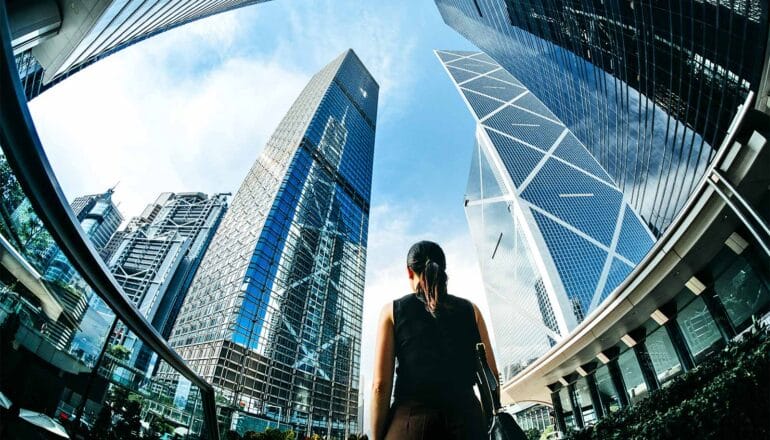
The air coming out of office buildings in urban areas may be more polluted than once believed, researchers say.
The new study in the journal Cell Reports Sustainability states modern buildings continually release volatile organic compounds (VOCs) to outdoor air and are likely to be an important contributor to the VOC burden of the urban atmosphere.
The team conducted direct measurements of outdoor-indoor air pollutant exchange in a high-performance office building using state-of-the-art air quality instrumentation and an advanced building automation platform.
“We traditionally think of filtering the outdoor air entering our buildings. Based on the findings of our study, we now need to consider cleaning the air leaving our offices, homes and schools to reduce VOC emissions to the outdoor environment,” says Brandon Boor, an associate professor in the Lyles School of Civil Engineering at Purdue University who led the study.
The aim of this research, Boor says, is to accurately measure VOCs in the air coming in and out of urban buildings and to use the data to understand how human occupancy and building operation affect VOC transport between indoor and outdoor air.
Boor says that the influence of air exchange between indoor and outdoor atmospheres on urban air pollution is still not well understood—nor had it been fully explored before in a modern office building with a sophisticated ventilation system.
“A fundamental understanding of the fate and transport of urban air pollutants is important for developing mitigation strategies and policies that can improve urban air quality and reduce adverse impacts on human health and the climate,” Boor says.
“Numerous studies have demonstrated the significant impact of traffic, industrial, and biogenic emissions on urban air pollution. However, the influence of urban air pollutant interactions with buildings has often been overlooked.”
Modern public and commercial buildings are typically equipped with heating, ventilation and air conditioning (HVAC) systems to provide improved indoor air quality and thermal comfort. When urban air is mechanically circulated throughout buildings, its composition can significantly change due to interactions with HVAC components, indoor air, occupants, and indoor surfaces.
“Buildings account for a significant fraction of the land area in cities and provide a significant amount of occupied indoor space,” says Tianren Wu, first author on the study and an assistant professor in the University of Cincinnati’s civil and architectural engineering and construction management department.
“To meet building ventilation and thermal comfort requirements, a substantial amount of air is actively exchanged between a building and its proximate urban atmosphere. This dynamic air exchange may have important implications for urban air quality due to both indoor-to-outdoor and outdoor-to-indoor transport and transformations of pollutants, especially in densely populated cities.”
Building materials, interior furnishings, and occupants and their activities—such as cooking, cleaning, and using consumer and personal care products—can release a variety of gaseous and particulate contaminants which can be directly exhausted into the urban atmosphere via a building’s HVAC system. Boor’s research found that indoor VOC concentrations are 2 to 15 times higher than outdoors and that per unit area, building emissions of VOCs are comparable to traffic, industrial, and biogenic emissions.
Notably, the team found the office to be a significant emission source of reactive monoterpenes and siloxanes to the outdoor environment. Siloxanes are widely used in deodorants, perfumes, lotions and hair care products. A recent study led by Purdue’s Nusrat Jung, assistant professor of civil engineering, found everyday hair care routines to release large amounts of siloxanes to outdoor air via bathroom exhaust, further demonstrating how buildings can impact outdoor air pollution.
“The building source-sink behavior changed dynamically with occupancy and building ventilation conditions,” Boor says. “Our results demonstrate that buildings can directly influence urban air quality due to substantial outdoor-indoor air exchange.”
As for what can be done to mitigate VOC emissions from buildings, Boor says a greater focus on removing VOCs in HVAC systems using carbon filters and other air cleaning technologies is needed. Using consumer and personal care products with low VOC emissions will also help, Boor says.
Boor’s team investigated the source and sink effects of a mechanically ventilated, realistic, open-plan office and its HVAC system on urban air pollutants through a comprehensive one-month field measurement campaign. The office used for their monthlong research is in the Ray W. Herrick Laboratories, a high-performance, LEED (Leadership in Energy and Environmental Design) Gold-certified building in central Indiana. The office is continuously mechanically ventilated by an independent air handling unit.
The field measurement campaign was performed during the winter season. Three types of common urban air pollutants were examined in the study, including VOCs, ozone, and fine particulate matter. The mechanical ventilation conditions of the building were carefully monitored to quantify net mass emission rates from the office and its HVAC system to the urban atmosphere. VOCs were measured in real time at different locations throughout the HVAC system with a high-resolution proton transfer reaction time-of-flight mass spectrometer.
Key takeaways:
- Modern buildings continually release volatile chemicals into the outdoor atmosphere.
- Buildings can be significant emission sources of reactive monoterpenes and siloxanes.
- Building source-sink behavior changes with human occupancy and ventilation conditions.
- Direct VOC emissions from buildings must be considered in urban air pollution models.
Researchers from Indiana University and RJ Lee Group Inc. also contributed to this study.
Support for the research came from the National Science Foundation and the Alfred P. Sloan Foundation.
Source: Purdue University
The post City office buildings pump polluted air outside appeared first on Futurity.
from Futurity https://ift.tt/9BpWdht
No comments:
Post a Comment